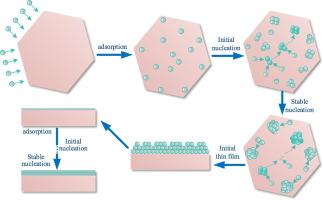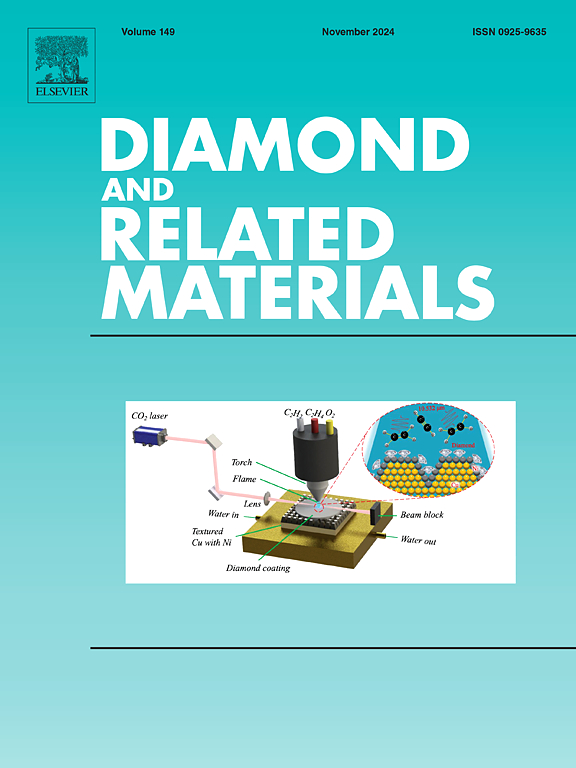Influence mechanism of magnetron sputtering process parameters on diamond surface preprocessing interface for chip heat sink
IF 4.3
3区 材料科学
Q2 MATERIALS SCIENCE, COATINGS & FILMS
引用次数: 0
Abstract
The interface between diamond and aluminum is poor in wettability and solid solubility. The interface bonding can be improved effectively by plating metal elements on diamond surface combined with heat treatment. In this paper, the influence of adjustable process parameters on the quality of Mo layer modified by magnetron sputtering was studied based on orthogonal experiments, and Mo-coated diamond/aluminum composite materials were prepared by Spark Plasma Sintering (SPS). The results indicate that the deposition of Mo layer on the diamond surface proceeds through three stages: adsorption, surface diffusion, and stable nucleus growth, forming an initial thin film, followed by layer-by-layer stacking through repeated growth of these stages. Sputtering time and sputtering pressure are the main factors affecting the quality of the coating. Mo layers prepared under conditions of 30 min and 0.5 Pa exhibit uniform and dense surface and moderate thickness. After heat treatment, recrystallization forms equiaxed grains, and Mo2C is formed in reaction with diamond, effectively enhancing the interface bonding strength between diamond and aluminum. The thermal conductivity of the diamond/aluminum composite material reached 342 W/(mK).

磁控溅射工艺参数对芯片散热器金刚石表面预处理界面的影响机理
金刚石和铝之间的界面润湿性和固体溶解性较差。在金刚石表面电镀金属元素并结合热处理可以有效改善界面结合。本文基于正交实验研究了可调工艺参数对磁控溅射改性钼层质量的影响,并采用火花等离子烧结(SPS)技术制备了钼涂层金刚石/铝复合材料。结果表明,钼层在金刚石表面的沉积经历了三个阶段:吸附、表面扩散和稳定的晶核生长,形成初始薄膜,然后通过这些阶段的反复生长逐层堆积。溅射时间和溅射压力是影响涂层质量的主要因素。在 30 分钟和 0.5 Pa 的条件下制备的钼层表面均匀致密,厚度适中。热处理后,再结晶形成等轴晶粒,与金刚石反应形成 Mo2C,有效提高了金刚石和铝之间的界面结合强度。金刚石/铝复合材料的热导率达到 342 W/(mK)。
本文章由计算机程序翻译,如有差异,请以英文原文为准。
求助全文
约1分钟内获得全文
求助全文
来源期刊

Diamond and Related Materials
工程技术-材料科学:综合
CiteScore
6.00
自引率
14.60%
发文量
702
审稿时长
2.1 months
期刊介绍:
DRM is a leading international journal that publishes new fundamental and applied research on all forms of diamond, the integration of diamond with other advanced materials and development of technologies exploiting diamond. The synthesis, characterization and processing of single crystal diamond, polycrystalline films, nanodiamond powders and heterostructures with other advanced materials are encouraged topics for technical and review articles. In addition to diamond, the journal publishes manuscripts on the synthesis, characterization and application of other related materials including diamond-like carbons, carbon nanotubes, graphene, and boron and carbon nitrides. Articles are sought on the chemical functionalization of diamond and related materials as well as their use in electrochemistry, energy storage and conversion, chemical and biological sensing, imaging, thermal management, photonic and quantum applications, electron emission and electronic devices.
The International Conference on Diamond and Carbon Materials has evolved into the largest and most well attended forum in the field of diamond, providing a forum to showcase the latest results in the science and technology of diamond and other carbon materials such as carbon nanotubes, graphene, and diamond-like carbon. Run annually in association with Diamond and Related Materials the conference provides junior and established researchers the opportunity to exchange the latest results ranging from fundamental physical and chemical concepts to applied research focusing on the next generation carbon-based devices.
 求助内容:
求助内容: 应助结果提醒方式:
应助结果提醒方式:


